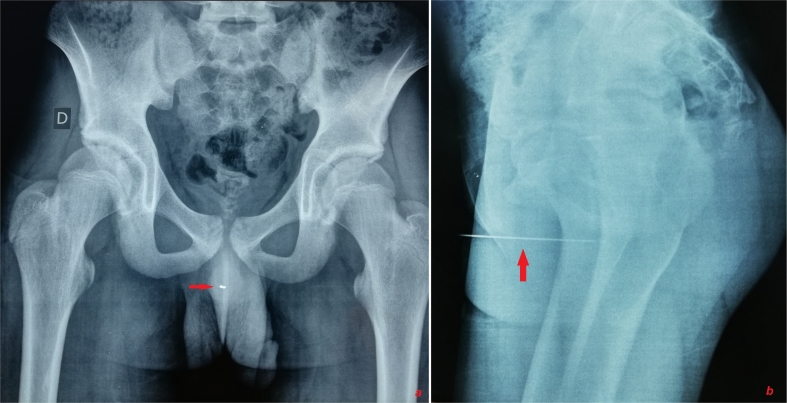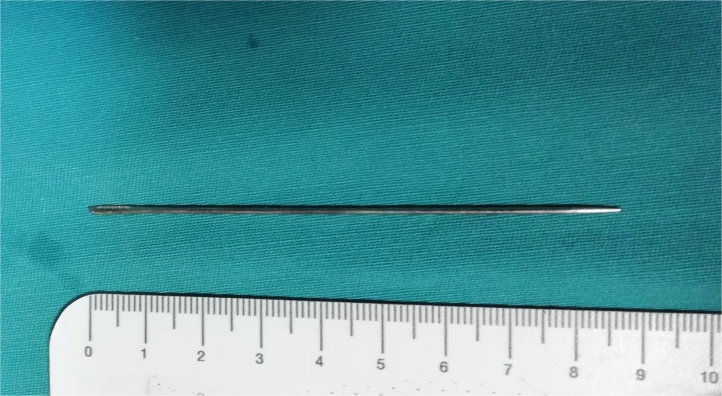Abstract
Urethral foreign bodies are rare in daily practice, especially in adolescents with no evident history of mental illness. The presentation is usually delayed and a wide variety of objects may be implicated. Treatment by minimally invasive procedures (endoscopy), if possible, is preferred to minimize bladder and urethral injuries and psychiatric evaluation is mandatory to detect an underlying mental disorder. Despite the available literature on self-inserted urethral foreign bodies; the case we report here of urethral self-insertion of a sewing needle in a 14 year-old boy for autoerotic stimulation is very rare.
Keywords: Foreign bodies, Urethra, Adolescent
Introduction
The insertion of foreign bodies into the urethra is an uncommon emergency in which a wide variety of objects has been implicated. The presentation is usually delayed owing to the emotion of shame and embarrassment. Despite the available literature on self-inserted urethral foreign bodies; the case we report here of urethral self-insertion of a sewing needle in a 14 year-old boy is very rare.
Case presentation
A 14-year-old boy, with no past medical history was referred to our department for dysuria for 3 days. There was no formal history of psychiatric disorders and detailed questioning revealed that he had self-inserted a sewing needle into his urethra for autoerotic stimulation. On examination, the needle was not visible, but palpable within the penile urethra, 5 cm far from urethral meatus. Plain X-ray of the pelvis revealed a linear radio-opaque foreign body below the symphysis pubis overlying penile soft tissue shadow, measuring approximately 9 cm.
Urethroscopy, under general anesthesia, showed a sharp sewing needle at the anterior urethra, lying along its longitudinal axis, which was successfully removed, using foreign body removal forceps.
Postoperative period was uneventful; the patient was discharged after one day and referred to the psychiatric department which confirmed that he had no mental trouble. School psychologist has also been involved in the patient follow up.
Discussion
Several cases reporting urethral foreign bodies are described in the literature,1 they affect both sexes, with a male predominance, and all age groups.2 The wide variety of self-inserted foreign bodies include needles, pencils, ball point pens, garden wire, copper wire, speaker wire, safety pins, telephone cables, straws, string, toothbrushes, Intrauterine Contraceptive Devices (IUCD), household batteries, light bulbs, marbles, cotton tip swabs, plastic cups, thermometers, plants and vegetables, and even parts of animals (leeches, squirrel tail, snakes, bones).3
Patients with urethral foreign body usually delay to consult due to embarrassment and shame. It also depends on the degree of discomfort as clinical presentation ranges from minor to moderate signs such as dysuria, pain, urinary frequency, strangury or hematuria to extremely grave infectious complications such as Fournier's gangrene.4 It's remarkable that the diagnosis can be made fortuitously after many years with no symptoms.
Causes of foreign bodies in lower urinary tract include psychological and psychiatric causes (mental illness, borderline personality disorder, and drug abuse), iatrogenic causes during urological procedures, traumatic causes and migration from other organs. Nevertheless, the most common motive is sexual or erotic in nature, such as masturbation or other forms of sexual variation or gratification and is not necessarily associated with psychiatric disorders or drug abuse.5 Moreover, lack of sex education in our country, both at home and school, for cultural and religious beliefs, might explain in part such behavior.
Diagnosis is based on a careful history taking (nature of foreign body, duration of insertion), physical examination that may reveal a hard urethral mass or complication (infection, gangrene) and radiologic evaluation. Plain pelvic images are sufficient in most cases as they are able to determine the size, location and number of foreign bodies involved. Thus, no further radiological exams are usually needed. However, radiolucent foreign bodies could be missed. In those cases, ultrasonography, contrast urethrography, computed tomography or cystoscopy is helpful to establish the diagnosis.
Extraction of an urethral foreign body may be challenging, thus, many means can be used to including non-operative means (using a basket or forceps), endoscopy like our case, or surgery, including urethrotomy and/or cystotomy if necessary. The shape of the foreign body, its consistency and its location, as well as the time of the consultation determines the extraction method. Minimally invasive procedures (endoscopy), if possible, are preferred to minimize bladder and urethral injuries and are usually successful.
Delayed complications such as urethral stricture can occur, so close follow-up is recommended if possible.
Conclusion
Urethral foreign bodies are rare in daily practice, especially in adolescents with no evident history of mental illness. Nevertheless, psychiatric evaluation is mandatory to detect an underlying mental disorder and to avoid repeat insertion.
Conflicts of interest
The authors declare that there are no conflicts of interest regarding the publication of this article (see Fig. 1, Fig. 2, Fig. 3).
Fig. 1.
Plain pelvic radiography (Anteroposterior (a) and lateral (b)) showing a radio-opaque foreign body (arrow) below the symphysis pubis.
Fig. 2.
Urethroscopy showing a sharp sewing needle at the penile urethra along its axis (a). Extracting the needle using foreign body removal forceps (b).
Fig. 3.
Sewing needle measuring 9 cm.
References
- 1.Osca J.M., Broseta E., Server G., Ruiz J.L., Gallego J., Jimenez-Cruz J.F. Unusual foreign bodies in the urethra and bladder. Br J Urol. 1991;68:510–512. doi: 10.1111/j.1464-410x.1991.tb15395.x. [DOI] [PubMed] [Google Scholar]
- 2.Van Ophoven A., De Kernion J.B. Clinical management of foreign bodies of the genitourinary tract. J Urol. 2000;164:274–287. doi: 10.1097/00005392-200008000-00003. [DOI] [PubMed] [Google Scholar]
- 3.Mannan A., Anwar S., Qayyum A., Tasneem R.A. Foreign bodies in the urinary bladder and their management: a Pakistani experience. Singap Med J. 2011;52(1):24–28. [PubMed] [Google Scholar]
- 4.Pec J., Straka S., Novomesky F., Kliment J., Pec M., Lazarova Z. Mechanical urethritis and ascendent genitourinary infections due to sexual stimulation of the urethra by inserted foreign bodies. Genitourin Med. 1992;68:399–400. doi: 10.1136/sti.68.6.399. [DOI] [PMC free article] [PubMed] [Google Scholar]
- 5.Prasad Ray, R., Ghosh, B., Pal, D.. Urethral foreign body in an adolescent boy: report of two rare cases and review of literature. Int J Adolesc Med Health, 27(4), pp. 463-465. doi:10.1515/ijamh-2014-0057. [DOI] [PubMed]





